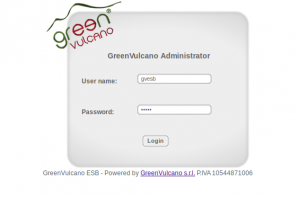Difference between revisions of "GV Console"
(→Report) |
(→SavePoint) |
||
| Line 35: | Line 35: | ||
* see the save point ([[SavePoint]]); | * see the save point ([[SavePoint]]); | ||
* Monitor the JVM ([[Monitoring]]). | * Monitor the JVM ([[Monitoring]]). | ||
| − | |||
| − | |||
| − | |||
| − | |||
| − | |||
| − | |||
| − | |||
| − | |||
| − | |||
| − | |||
==Monitoring== | ==Monitoring== | ||
Revision as of 14:08, 24 January 2012
Definition
Once a service has been created, the user must be able to manage all the GreenVulcano® ESB infrastructure and monitoring the system on which it is working. Adding to these services its respective system, channel, operations, together with other elements valid for the GreenVulcano® ESB correct operation, the level of complexity increases. It is therefore necessary to have visibility and control system performance.
For this reason it was created the GV Console. Basically it is a Web Application which can centrally manage, monitor and administer all the GreenVulcano® ESB instances, making also easer the server application deployment and its posterior monitoring and maintenance.
Access
GreenVulcano® ESB Console is available at:
- http://ipAddress:port/gvconsole
(Ex. http://localhost:8080/gvconsole)
where ipAddress is the server address where the application has been deployed and gvconsole is the name given to the web console.
In order to display the web console, user must login by submitting a valid administrative username and password.
GV Console Menu
With the GV Console you can:
- deploy a new service (Deploy New Services);
- configure a parameter directly into the XML document (Parameter);
- configure the web service (Web Service);
- use the GV Console Tools (Utility)
- test the GreenVulcano® ESB services (Testing);
- view the log messages (Log)
- create reports (Report);
- see the save point (SavePoint);
- Monitor the JVM (Monitoring).
Monitoring
It is possible to access this area clicking on "Monitoring":


